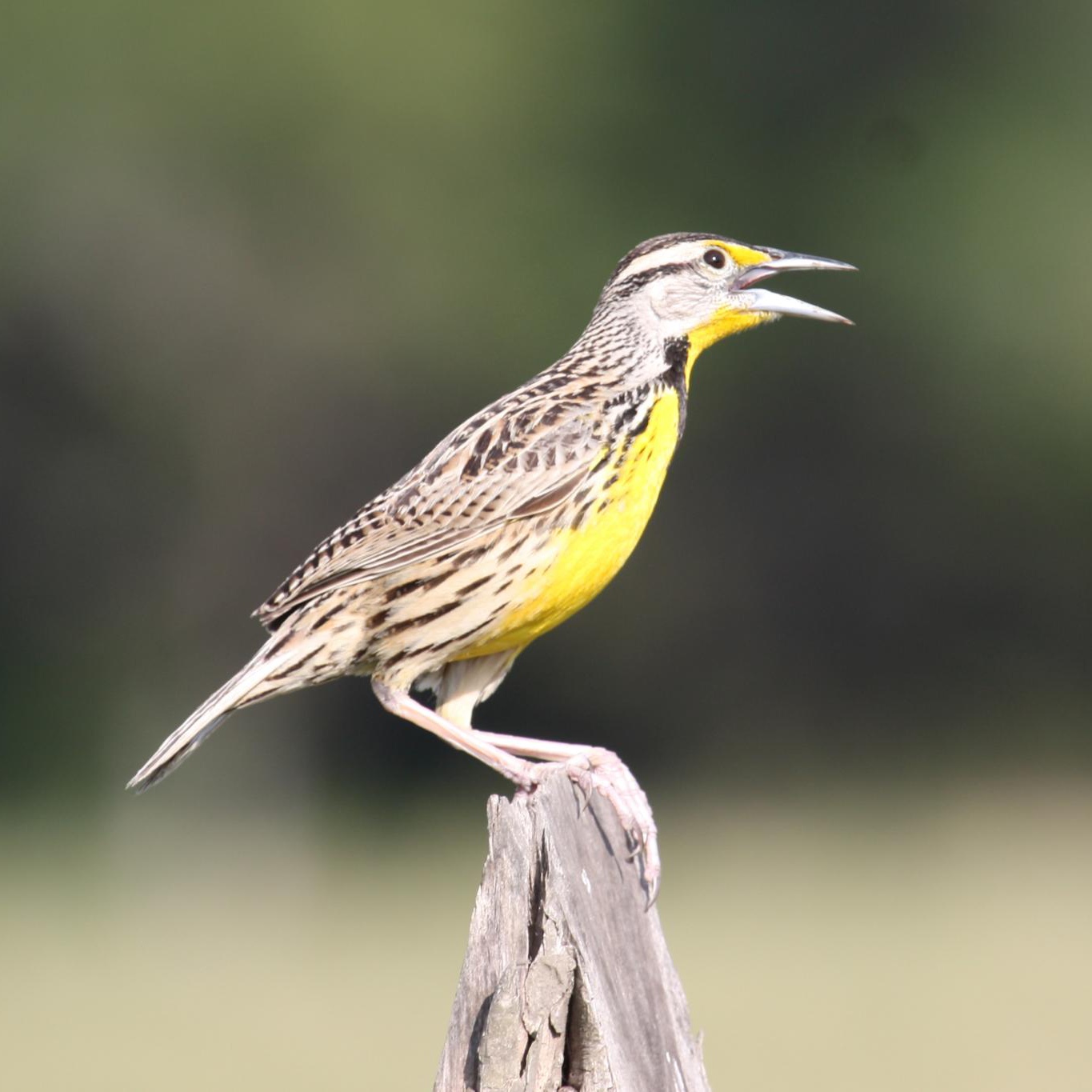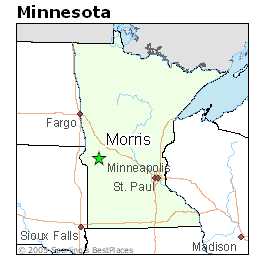 |
| I miss the meadowlark and its call. |
I remember meadowlarks around Morris when I was young. Not in town but out in the countryside, as the name implies.
But the name is also a little misleading. It's not a member of the lark family - actually it belongs to the blackbird family and is related to grackles and orioles.
Meadowlarks were a very pleasant avian companion around Morris, but I can't remember the last time I saw (or heard) one. Something unfortunate has happened with their habitat, I presume.
My bird reference manual has a map showing the Eastern Meadowlark residing in the eastern half of Minnesota, not making it over here. But it's hard to understand why they wouldn't, because on the surface at least, we seem perfectly suited to their lifestyle. It's a bird of open grassy country. It loves the meadows and probably got the "lark" syllable tacked on because it sings like the larks of Europe.
My manual describes their song as "a flute-like, clear whistle."
That radio commercial was as effective as any alarm and far more aesthetically pleasing. It's a shame this bird apparently doesn't populate this neck of the woods (or prairie) anymore. We can get a bear in Morris but the meadowlarks seem gone.
Bird territory maps are not gospel. A woman who is probably the No. 1 local bird guru, Margaret Kuchenreuther - don't confuse her with Krattenmaker - told me this once. I called her excitedly one day to inform her that a gray jay had passed through our back yard. I was able to zero in with binoculars and there was absolutely no doubt: it was a "gray jay" or "Whisky Jack" or "Canada Jay."
Our family has an ambitious bird feeding station in the back yard, so a variety can be expected. I couldn't have made the gray jay identification on first sight. I had to flip through the manual. Upon finding the right page, there was no doubt. But the territory map shows this bird restricted to the northeast one-third of the state.
Margaret said it isn't unusual at all for birds to stray beyond their expected boundaries, because after all "they can fly," for one thing.
"Camp robber" is another of the gray jay's names. It rummages through camps looking for food scraps. It's also easily tamed and might fly to your hand if you offer it raisins or nuts. Our backyard visitor didn't stay long enough for me to try the food offering.
I've read that chickadees might do the same thing. Chickadees are a very resilient bird that will always be the first to find a new feeding apparatus. They are a reassuring winter companion just like the dark-eyed junco.
We feel special affinity with the junco which seems so unfazed and indifferent about winter. The bird is gregarious as you'll note when you see them always in groups. They hop about on the ground looking for sustenance, "double-scratching" with both feet simultaneously to expose seeds and insects. They consume many weed seeds.
I always put out black-oil sunflower seeds which I have found to be the best all-purpose back yard wildlife food. The squirrels love it. It's common for people to discourage squirrels but we don't. At the time I gave up hunting many years ago, I adopted the philosophy "live and let live."
Margaret gave me a heads-up about the wondrous bird-watching opportunities at Niemackl Park. The park is an expansive, tree-filled place south of Herman that breaks up the predominance of our prairie atmosphere.
For years I associated Niemackl with the annual "iron pour" art event held there. I covered that in my corporate media career. I confess I can't describe what the "iron pour" process really is. But I say "hats off" because it seems very unique and inviting, and of course it attracts some very interesting people. It's a nice contrast to the other "festival" type events in the area that can be predictable (with their parades with waving queens, candy-throwing etc.).
I made one springtime excursion to Niemackl for bird-watching and found myself completely alone (in terms of humans). Yes it was peaceful. An unemployed person like yours truly can get a little too much peace sometimes. But it was neat to get onto the trails of Niemackl, under no pressure to get anything done, and soak in the nature.
My, there were sounds of birds everywhere - a veritable cacophony. I found it difficult to locate specific birds for identification and analysis.
But there was some success, like observing an American redstart and a yellow-rumped warbler. The male American redstart is a small, striking black bird with contrasting patches of orange on sides, wings and tail, and a white belly. Sorry, the female is not as attention-getting with appearance. My manual says this bird prefers large unbroken tracts of forest. So you might not find many, or any, outside this park in our area.
Everyone in our area should visit Niemackl once and stroll along the organized trail system. There can be one drawback: woodticks. I hate to bring this up but I wouldn't want anyone to be surprised. Take away this black mark and it's a totally wonderful place.
The yellow-rumped warbler is one of the first warblers to return to Minnesota, arriving in April. It builds a cup nest in coniferous and aspen forests. I find its most striking feature to be yellow patches on the rump, flanks and head. Again the female is duller, but she does have the same yellow patches.
There are lots of yellow-headed blackbirds around Niemackl Park. Niemackl has deep-water marshes of the type this bird finds ideal for nesting.
The red-winged blackbird, which can be ubiquitous around the bike trail east of Morris (and by the Pomme de Terre River), prefers shallow water.
The yellow-headed blackbird with its lemon yellow head has a call quite different from other blackbirds: a low, hoarse and raspy call.
Margaret told me some scarlet tanagers could be seen at Niemackl at the time I made my trip. I struck out on that one. Again, there were birds to be heard everywhere but it was often difficult pinpointing them.
Our backyard birdfeeding station has had many distinctive visitors although not as many this past spring. Two years ago we had rose-breasted grosbeaks. I excitedly called Margaret upon seeing these and asked if this might be a significant (rare) sighting. She said no, that there were pockets of these birds locally.
I also came home one night to find an indigo bunting hopping around in the back yard.
Nobody considers the grackle to be an interesting bird but our family relishes the sight of the first grackles of spring. We also relish later on the sight of the "little grackles" flapping their wings to get their parents' attention in order to get fed.
The nuthatch is a fascinating bird because it's upside down so much on the sides of trees or on a suet cake. Two years ago I noticed two different varieties of nuthatches visiting us through winter. One was a little smaller and red-breasted. I consulted my manual and learned that the red or orange-breasted ones were outside of their expected territory - another example of what Margaret was talking about (the tendency not to be confined).
A couple months later there was an article in the Star Tribune about how the red-breasted (really more like orange) nuthatch was settling outside of its normal range that winter. It's a friendly and tame little bird, often not "spooking" when I go out to tend to the station.
The manual describes the color as "rust red." I should probably consult my old color aficionado friend, Lynn Klyve (now Lynn Clark). Lynn was a co-worker of mine in the print media, an absolutely vivacious and attractive individual. I miss Lynn just like I miss the meadowlark.
I have learned that women don't appreciate it when you seek to describe their hair color after first consulting the Sherwin Williams website.
Back to birds: The nuthatch will wedge a seed into a crevice and pound it open with several sharp blows.
All of these birds are wondrous companions here on the prairie, enhancing the backdrop in a way we might take for granted. But I would be even more invigorated to find our old companion the Eastern Meadowlark giving its distinctive call from fenceposts in the open prairie ground. Just like in the old days.
As for waking up in the morning, that radio commercial was quite effective but this was in the days before I discovered caffeine. The myth back then was that coffee-drinking as an adolescent might stunt your growth. It seems like that stunting business was used by adults in bygone times to discourage youth from engaging in several undesirable behaviors, all of which I wouldn't list here for reasons of taste.
Kids might also be warned they'd go blind. Looking back, I wish I had consumed coffee in the morning because it's a superb jump-start.
As for listening to the radio in the morning, I don't anymore because TV is available 24 hours a day in all its multi-channel glory. We of course take it for granted. It's not like in the days when many of us had but one TV station available: KCMT of Alexandria.
Would a meadowlark call send me subconsciously into my youthful frame of mind? That wouldn't be necessary. I would just like to feel the joy that comes with realizing this colorful and appealing bird is in our area, again
-Brian Williams - morris mn Minnesota - bwilly73@yahoo.com






















No comments:
Post a Comment